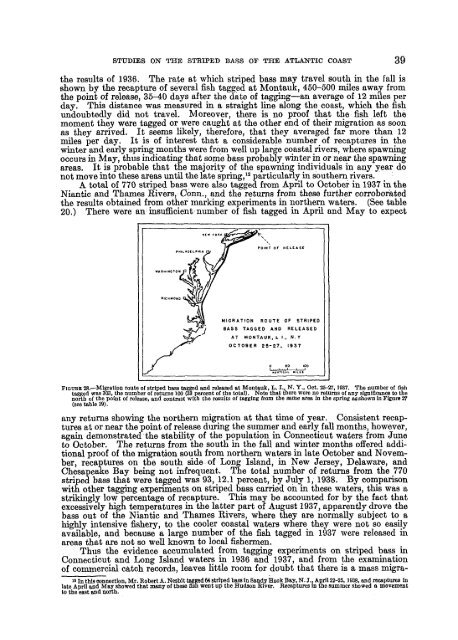Fishery bulletin of the Fish and Wildlife Service - NOAA
Fishery bulletin of the Fish and Wildlife Service - NOAA
Fishery bulletin of the Fish and Wildlife Service - NOAA
Create successful ePaper yourself
Turn your PDF publications into a flip-book with our unique Google optimized e-Paper software.
STUDIES ON THE STRIPED BASS OF THE ATLANTIC COAST 39<br />
<strong>the</strong> results <strong>of</strong> 1936. The rate at which striped bass may travel south in <strong>the</strong> fall is<br />
shown by <strong>the</strong> recapture <strong>of</strong> several fish tagged at Montauk, 450-500 miles away from<br />
<strong>the</strong> point <strong>of</strong> release, 35-40 days after <strong>the</strong> date <strong>of</strong> tagging—an average <strong>of</strong> 12 mUes per<br />
day. This distance was measured in a straight Une along <strong>the</strong> coast, which <strong>the</strong> fish<br />
undoubtedly did not travel. Moreover, <strong>the</strong>re is no pro<strong>of</strong> that <strong>the</strong> fish left <strong>the</strong><br />
moment <strong>the</strong>y were tagged or were caught at <strong>the</strong> o<strong>the</strong>r end <strong>of</strong> <strong>the</strong>ir migration as soon<br />
as <strong>the</strong>y arrived. It seems likely, <strong>the</strong>refore, that <strong>the</strong>y averaged far more than 12<br />
miles per day. It is <strong>of</strong> interest that a considerable number <strong>of</strong> recaptures in <strong>the</strong><br />
winter <strong>and</strong> early spring months were from well up large coastal rivers, where spawning<br />
occurs in May, thus indicating that some bass probably winter in or near <strong>the</strong> spawning<br />
areas. It is probable that <strong>the</strong> majority <strong>of</strong> <strong>the</strong> spawning individuals in any year do<br />
not move into <strong>the</strong>se areas until <strong>the</strong> late spring, 12 particularly in sou<strong>the</strong>rn rivers.<br />
A total <strong>of</strong> 770 striped bass were also tagged from April to October in 1937 in <strong>the</strong><br />
Niantic <strong>and</strong> Thames Rivers, Conn., <strong>and</strong> <strong>the</strong> returns from <strong>the</strong>se fur<strong>the</strong>r corroborated<br />
<strong>the</strong> results obtained from o<strong>the</strong>r marking experiments in nor<strong>the</strong>rn waters. (See table<br />
20.) There were an insufficient number <strong>of</strong> fish tagged in April <strong>and</strong> May to expect<br />
MIGRATION ROUTE OF STRIPED<br />
BASS TAGGED AND RELEASED<br />
AT MONTAUK, L I., N. Y<br />
OCTOBER 25-27. I9ÎT<br />
FIOUBE 28.—Migration route <strong>of</strong> striped bass tagged <strong>and</strong> released at Montauk, L. I., N. Y., Oct. 25-27,1937. The number <strong>of</strong> fish<br />
tagged was 303, <strong>the</strong> number <strong>of</strong> returns 100 (33 percent <strong>of</strong> <strong>the</strong> total). Note that <strong>the</strong>re were no returns <strong>of</strong> any significance to <strong>the</strong><br />
north <strong>of</strong> <strong>the</strong> point <strong>of</strong> release, <strong>and</strong> contrast with <strong>the</strong> results <strong>of</strong> tagging from <strong>the</strong> same area In <strong>the</strong> spring as shown In Fleure 27<br />
(see table 19).<br />
any returns showing <strong>the</strong> nor<strong>the</strong>rn migration at that time <strong>of</strong> year. Consistent recaptures<br />
at or near <strong>the</strong> point <strong>of</strong> release during <strong>the</strong> summer <strong>and</strong> early fall months, however,<br />
again demonstrated <strong>the</strong> stability <strong>of</strong> <strong>the</strong> population in Connecticut waters from June<br />
to October. The returns from <strong>the</strong> south in <strong>the</strong> fall <strong>and</strong> winter months <strong>of</strong>fered additional<br />
pro<strong>of</strong> <strong>of</strong> <strong>the</strong> migration south from nor<strong>the</strong>rn waters in late October <strong>and</strong> November,<br />
recaptures on <strong>the</strong> south side <strong>of</strong> Long Isl<strong>and</strong>, in New Jersey, Delaware, <strong>and</strong><br />
Chesapeake Bay being not infrequent. The total number <strong>of</strong> returns from <strong>the</strong> 770<br />
striped bass that were tagged was 93, 12.1 percent, by July 1, 1938. By comparison<br />
with o<strong>the</strong>r tagging experiments on striped bass carried on in <strong>the</strong>se waters, this was a<br />
strikingly low percentage <strong>of</strong> recapture. This may be accounted for by <strong>the</strong> fact that<br />
excessively high temperatures in <strong>the</strong> latter part <strong>of</strong> August 1937, apparently drove <strong>the</strong><br />
bass out <strong>of</strong> <strong>the</strong> Niantic <strong>and</strong> Thames Rivers, where <strong>the</strong>y are normally subject to a<br />
highly intensive fishery, to <strong>the</strong> cooler coastal waters where <strong>the</strong>y were not so easily<br />
available, <strong>and</strong> because a large number <strong>of</strong> <strong>the</strong> fish tagged in 1937 were released in<br />
areas that are not so well known to local fishermen.<br />
Thus <strong>the</strong> evidence accumulated from tagging experiments on striped bass in<br />
Connecticut <strong>and</strong> Long Isl<strong>and</strong> waters in 1936 <strong>and</strong> 1937, <strong>and</strong> from <strong>the</strong> examination<br />
<strong>of</strong> commercial catch records, leaves little room for doubt that <strong>the</strong>re is a mass migra-<br />
>' In this connection, Mr. Robert A. Nesblt tagged M striped bassin S<strong>and</strong>y Hook Bay, N. J.. April 22-25, 1938, <strong>and</strong> recaptures In<br />
late April <strong>and</strong> May showed that many <strong>of</strong> <strong>the</strong>se fish went up <strong>the</strong> Hudson Hiver. Recaptures In <strong>the</strong> summer showed a movement<br />
to <strong>the</strong> east <strong>and</strong> north.

















